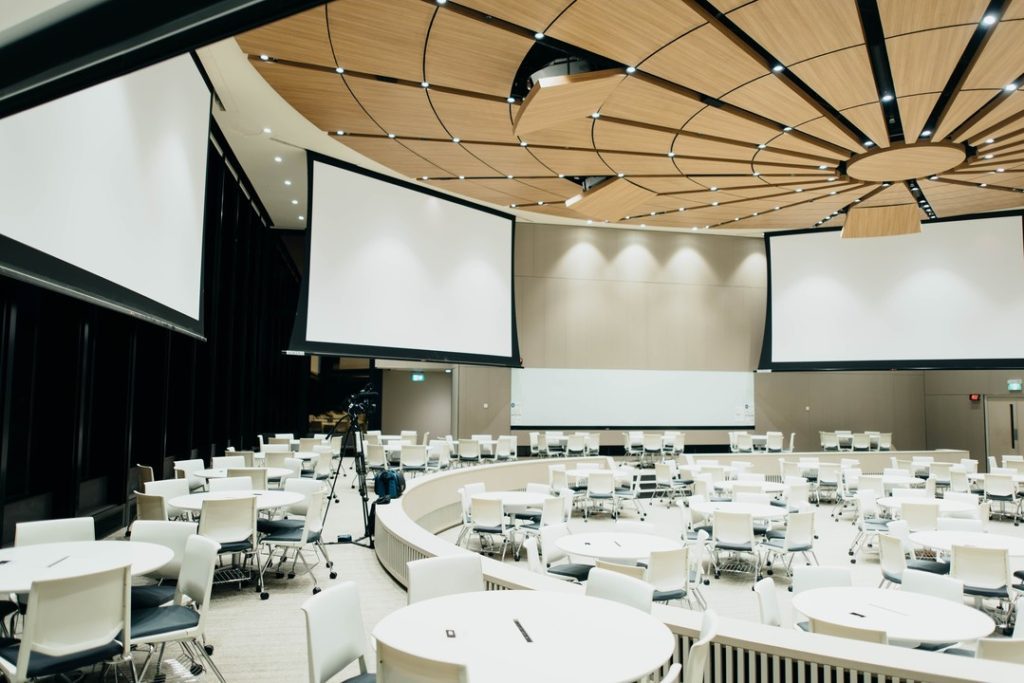Where businesses are constantly evolving, so too must the spaces they inhabit. Gone are the days of rigid office layouts and single-use rooms. The future of interior design and technology lies in adaptability—spaces that can transform at a moment’s notice to meet the ever-changing needs of modern work environments..
The yearly NeoCon design convention is an invaluable event for gaining insights into emerging trends and innovations in adaptable interior design. Showcasing the latest in commercial design with a focus on aesthetics and sustainability, it emphasizes the importance of integrating technology with design to create adaptable spaces that meet modern business needs.
Let’s dive into some key aspects of interior design and their relationship with forward-thinking AV solutions.
The Role of Interior Design in AV
Adaptable interior design has become essential in today’s corporate environments, where spaces must be both dynamic and efficient. Growing demand for versatility has led to the creation of multipurpose meeting spaces, made by transforming conventional spaces like concession areas or open stairways into something entirely new and useful. Additionally, advanced solutions like soundproof temporary environments offer a glimpse into the future, where spaces can be reconfigured without extensive renovations.
This fusion of beauty and utility is revolutionizing how we perceive and use interior spaces, with the goal of enhancing experiences for businesses and their clients all over the globe.
The Shift Towards Adaptability
Adaptability in design has evolved from a novel idea to a necessity in modern workplaces. Businesses now prioritize spaces that can serve multiple functions without sacrificing aesthetics or utility.
Innovations like movable walls and modular furniture enable quick reconfigurations, maximizing space usage and reducing the need for renovations. This trend also nods to a global prioritization of sustainability, minimizing material waste and energy consumption.
As work patterns shift unpredictably, adaptable designs offer a strategic advantage and are set to become a cornerstone of future-ready workspaces.
Bridging Aesthetics and Functionality
Achieving the right balance between aesthetics and functionality is central to adaptable interior design. High-quality materials and integrated technology are key to transforming spaces without losing visual appeal. Designers are increasingly using elements like dynamic lighting and smart furniture to create elegant, practical workspaces.
Collaboration between architects, designers, and technologists is crucial for creating environments that are both beautiful and efficient. Importantly, engaging technologists early in the process ensures the end-goals for marrying rich tech and design are successful. By prioritizing both form and function, adaptable interior design enhances productivity and satisfaction in the workplace.
Challenges in Multi-Functional Spaces
Multi-functional spaces come with excitement––but not without challenges. Particularly, many businesses’ needs to balance diverse priorities within limited areas can create unique roadblocks for the designers and technicians.
Ensuring smooth transitions between different functions—such as converting a cafeteria into a meeting area—requires careful consideration of acoustics, lighting, and furniture placement. Integrating technology seamlessly into these spaces can also be complex, requiring attention to wiring, connectivity, and equipment placement.
Addressing the varied needs of users, from comfort to accessibility, is also essential for creating inclusive, adaptable spaces. Despite these challenges, successfully navigating them leads to environments that boost productivity and satisfaction.
Innovative Products in Design
Temporary architectural environments and dynamic display screens represent a significant recent innovation in adaptable interior design. Temporary structures like modular walls allow spaces to be reconfigured quickly and cost-effectively, making them ideal for corporate settings with evolving spatial needs..
These innovations not only enhance the visual appeal of a variety of spaces, but also improve their functionality and versatility––opening the door for more possibilities and setting the stage for the future of interior design.
A New Era of Workspaces
As the demand for flexible, multi-functional spaces continues to rise, the future of interior design and tech is clear: adaptability is no longer a luxury; it’s a necessity. By embracing innovative solutions that merge technology with design, businesses can create environments that evolve with them, enhancing both productivity and creativity. Whether it’s temporary structures or interactive displays, adaptability is paving the way for a new era of workspaces—ones that are as agile as the companies they serve. The time to invest in this transformation is now, offering a competitive edge and setting the stage for a more efficient, future-ready world.



